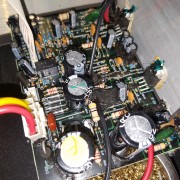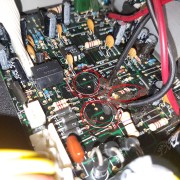Hi,
I have a pair of KRK Rokit RP5 G2 monitors but on one of them when you only turn on the power it makes a horrible loud buzzing sound:
VIDEO: https://sendvid.com/rsojf518
I have tried the woofer from a working unit into it and it does the same problem so it has to be an issue with the actual unit. I have opened it up and took photos.
I tried taking the two capacitors out and the red/black cable to the woofer and re-seating but the problem still persists.
Does anyone know what is causing this problem?
Thanks
KRK Rokit has Loud Buzzing, why?
This could be a capacitor leakage problem.
What does capacitor leaking mean?
When people say the caps are leaking, it doesn't mean physically leaking, it means they are leaking voltage. In most cases you can't see a bad cap, you need to test it.
Can I get hurt checking a leaking capacitor?
Sometimes a capacitor (cap) can hold a charge. You could damage something discharging it or worse yet... hurt yourself!
Can I check the capacitor while its still in the board?
You can't test a capacitor while it's still in the board as the other components it's connected to will falsify any reading you get.
Your hum frequency is 100Hz with both odd and even harmonics, so the problem must be on the mains frequency (front) end of the power supply before the rectified voltage is sent to the high-frequency switcher. It means there are not many things that could be causing this fault: it has to be a failed rectifier or a failed capacitor. Unless you are suitably experienced in dealing with live 400V circuitry, I would strongly advise taking it to a repair shop.
Comments
1. None of the caps look damaged though, so how will I know whic
1. None of the caps look damaged though, so how will I know which are the bad ones?
2. I took a photo of my working one, and it looks pretty much the same:
https://ibb.co/d0JwaQ
3. If I was to take it to a repair store how much would it be roughly? I mean the monitors to buy are only £100.
just check them all. be careful, sometimes a cap can hold a char
just check them all. be careful, sometimes a cap can hold a charge. you can damage something discharging it or worse yet hurt yourself.
Rowan88, post: 451554, member: 50729 wrote: If I was to take it to a repair store how much would it be roughly? I mean the monitors to buy are only £100.
welcome to the World of disposable audio gear. you are right. best thing is to buy new monitors.
You can't test a capacitor while it's still in the board as the
You can't test a capacitor while it's still in the board as the other components it's connected to will falsify any reading you get.
Your hum frequency is 100Hz with both odd and even harmonics, so the problem must be on the mains frequency (front) end of the power supply before the rectified voltage is sent to the high-frequency switcher. It means there are not many things that could be causing this fault: it has to be a failed rectifier or a failed capacitor. Unless you are suitably experienced in dealing with live 400V circuitry, I would strongly advise taking it to a repair shop.
I tinkered about a little more this morning. I tried removing th
I tinkered about a little more this morning. I tried removing the two large black capacitors and also the one on R108 (small white/red one) and swapped them with ones I know are ok from my working unit. The problem persisted so I can rule them out?
Is there any other components I should have a look into swapping with the working unit to narrow down what the faulty part could be?
Are you sure the ones you swapped were the reservoir capacitors
Are you sure the ones you swapped were the reservoir capacitors in the mains end of the power supply and not the amplifier output coupling caps? What was the capacity and voltage rating on them?
If you have a reasonable multimeter, one thing you could try is comparisons between the faulty speaker and the good one. BEFORE YOU DO THE FOLLOWING WORK YOU MUST UNPLUG THE MAINS LEADS FROM BOTH THE SPEAKERS AND GO ROUND SHORTING OUT EACH OF THE LARGE CAPACITORS FOR 5 - 10 SECONDS USING THE SHAFT OF A SCREWDRIVER WITH INSULATED HANDLE.
But first, you must identify where the mains rectifier and smoothing components are. I don't know the innards of those particular speakers, so I can't help you with location, but a clue would be to find the mains switch terminals and follow the wires or circuit board tracks from there. I also cannot tell if there is a single bridge rectifier or individual diodes - you will have to do this by inspection. If you post a higher-resolution photo of the circuit board, I can give you some idea of where to look - the photo you posted is only 20KB and so is of no use when enlarged.
Open the backs of both speakers and use the multimeter on volts range to check that the capacitors are fully discharged. If you don't do this, you risk blowing up your multimeter on the next set of tests. Using the ohms range, take measurements across the terminals of the mains rectifier and reservoir capacitor components, alternating between the faulty unit and the good one. Make each measurement twice with the meter leads reversed the second time. A good rectifier will show a very different reading with the leads reversed, and you may have to change the resistance range on the meter to get sensible readings. What you are looking for is a reading that is substantially different from the same measurement made on the good unit, e.g. either high or low in both directions.
Pay attention to the advice detailing the shunting of the voltag
Pay attention to the advice detailing the shunting of the voltages on the storage capacitors. Seriously. If you get across one of these at 400vdc it can cook you quickly. Since you have voided any possible warranty, calling on KRK for a new unit isn't a possibility.







This seems to be a classic capacitor leakage problem. Many years
This seems to be a classic capacitor leakage problem.
Many years back some cap makers put out some cheap batch and they nearly all went bad. I worked on thousands of computer motherboard which the cap where defective.
Most of the time we would replace the board but in some cases were it was impossible to find a compatible replacement. We would have to fix it by replacing the cap.
The same issus happened to powersupplies and we changed a lot of PWS during those years.
The thing is, it seems like they were ment to work for the duration of the warranty so we can blame it on a clever dollar hungry market...
Your case seems very bad and could have affected other component.
The best thing to do is to put out the board, mark the caps that has leaked and clean everything well. Then change those caps and retest.
If you are not confident in electronic diagnosis, I suggest you send it to a repair shop.